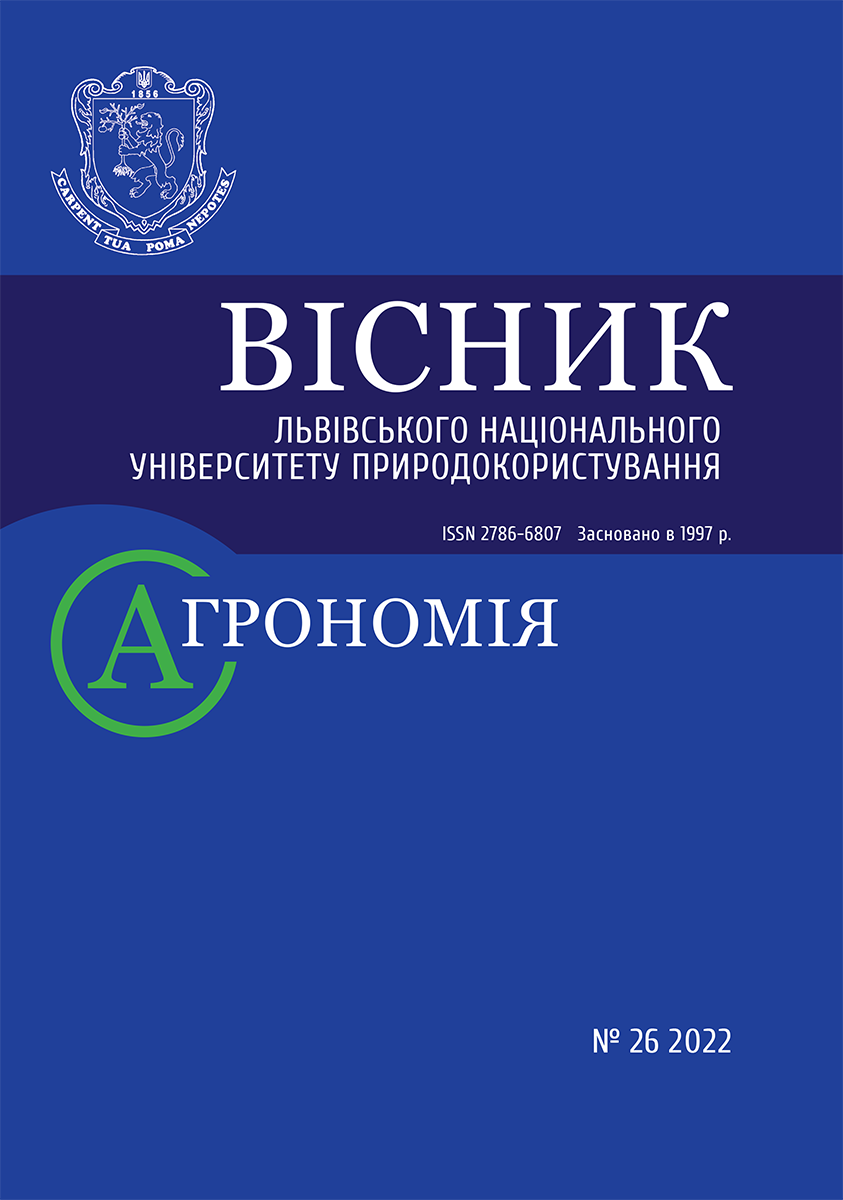INFLUENCE OF NITROGEN FERTILIZERS ON THE FORMATION OF CORN GRAIN YIELD AND NITROGENUSE EFFICIENCY
DOI:
https://doi.org/10.31734/agronomy2022.26.170Keywords:
corn, fertilizers, nitrogen, yield, grain qualityAbstract
The yield potential of modern maize hybrids has increased significantly. It is important to analyze the probable optimal rates of corn fertilization in the Small Polissya zone on sod-carbonate soils to realize the biotic potential of the crop. The aim of our study was to determine the agronomic and economic feasibility of increasing the nitrogen fertilizer rate of Pioneer P9071 (Maxim XL) hybrid corn for maximum yield. The research methods – field and laboratory.
Geographical coordinates of the research site location: 49 ° 95′31 N 24 ° 84′83 ″ E. Five repetitions of the variants were used. Placement of the variants is randomized. The total area of the plot is 35 m2, accounting area – 15 m2. Corn cultivation techniques – traditional with the use of shelf cultivation. The planting rates of the hybrid was 78 000 seeds per hectare. Predecessor – winter wheat.
Mathematical and statistical processing of the obtained research results and yield data was carried out using Microsoft Excel and Statistica 12.0. Data in the tables and graphs are presented as arithmetic mean with the standard deviation (x ± SD).
Increasing the application of nitrogen fertilizers for corn from N90 to N125-150 improved biometric properties of the crop in such indicators as the weight of grain in the cob and the weight of 1000 grains. Maize grain yield was formed maximum when the N150 norm was applied, but it did not differ significantly from the N125 norm and amounted to 12.99–13.28 t/ha, which was 20.8–23.5 % more than in the control without nitrogen application. The yield of each additional kilogram of nitrogen in corn grain gradually reduced. Maximum nitrogen levels did not improve the content of fats and proteins in grain, but due to the increase in its collection led to a significant increase in nutrient yield to the highest level – 0.44 t/ha of fats and 1.26–1.29 t/ha of protein. According to the results of studying the effect of nitrogen fertilizer rates on the productivity of corn, the authors of the research recommend applying N125 with the division of the rate into two doses: N90 for pre-sowing cultivation and N35 – in the phase ВВСН 16–17. This ensured the production of 12.99 t/ha of high quality grain at lower nitrogen fertilizer costs.
References
Adotey N., McClure A., Raper T. Visual Symptoms: A Handy Tool in Identifying Nutrient Deficiency in Row Crops. 27 JUL 2020. URL: https://news.utcrops.com/2020/07/visual-symptoms-a-handy-tool-in-dentifying-nutrient-deficiency-in-row-crops (Accessed 22 April 2022).
Andrushchenko V., Debruin D., Butzen S. Nitrogen consumption by corn. Agronomist. 2019. No 1. P. 132–138. URL: https://www.agronom.com.ua/spozhyvannya-azotu-kukurudzoyu (Accessed 22 April 2022).
Banziger M., Betran F. J., Lafitte H. R. Efficiency of high nitrogen environment for improving maize for low nitrogen environment. Crop Sci. 1997. Vol. 37. P. 1103–1109.
Below F. The Seven Wonders of the Corn Yield World. 2018. URL: http://cropphysiology.cropsci.illinois.edu/research/seven_wonders.html (Accessed 22 April 2022).
Bender R. R., Haegele J. W., Ruffo M. L., Below F. E. Nutrient uptake, partitioning, and remobilization in modern, transgenic insect-protected maize hybrids. Agron J. 2013. 105:161–170.
Biswas D. K., Ma B. L. Effect of nitrogen rate and fertilizer nitrogen source on physiology, yield, grain quality, and nitrogen use efficiency in corn. Can J Plant Sci. 2016. Vol. 403. P. 392–403.
Bundy L. G. Side dressing nitrogen: useful on all soils? Proc. of the 2006 Wisconsin Fertilizer, Aglime&Pest Management Conference. 2006. Vol. 45. Pp. 39–43. URL: http://citeseerx.ist.psu.edu/viewdoc/download? DOI: 10.1.1.612.501&rep=rep1&type=pdf (Accessed 22 April 2022).
Coque M., Gallais A. Genetic Variation for Nitrogen Remobilization and Postsilking Nitrogen Uptake in Maize Recombinant Inbred Lines: Heritabilities and Correlations among Traits. CropScience. 2007. Vol. 47. P. 1787–1796.
Gallais A., Coque M., Quillere I., Prioul J. L., Hirel B. Modelling postsilking nitrogen fluxes in maize (Zea mays) using N-15-labelling field experiments. New Phytol., 2006. Vol. 172. P. 696–707.
Haegele J. W., Cook K. A., Nichols D. M., Below F. E. Changes in nitrogen use traits associated with genetic improvement for grain yield of maize hybrids released in different decades. Crop Sci. 2013. Vol. 53. P. 1256–1268.
Halvorson A. D., Grosso S.J.D., Alluvione F. Nitrogen Source Effects on Nitrous Oxide Emissions from Irrigated No-Till Corn. Journal of Environmental Quality. 2010. Vol. 39. P. 1554–1562.
Lohinova I. Secrets of corn success. Agroindustry. 2019. No 7. P. 22–32. URL: https://infoindustria.com.ua/sekreti-kukurudzyanogo-usipihu/ (Accessed 22 April 2022).
Lykhochvor V. V., Petrychenko V. F. Physiological role of nutrients and fertilizer systems of field crops: 3rd ed., Revised. Lviv: Ukrainian Technologies, 2021. 284 p.
Marchezan С., Paulo A., Ferreira A., Leandro S., et. al. Nitrogen Availability and Physiological Response of Corn After 12 Years with Organic and Mineral Fertilization. Journal of Soil Science and Plant Nutrition. 2020. Vol. 20 (3). P. 979–989.
Masclaux-Daubresse C., Daniel-Vedele F., Dechorgnat J., Chardon F., Gaufichon L., Suzuki A. Nitrogen uptake, assimilation and remobilization in plants: challenges for sustainable and productive agriculture. Ann Bot. 2010 Jun/ Vol. 105 (7). P. 1141–1157.
Omonode R. A., Halvorson A. D., Gagnon B., Vyn T. J. Achieving Lower Nitrogen Balance and Higher Nitrogen Recovery Efficiency Reduces Nitrous Oxide Emissions in North America's Maize Cropping Systems. Front Plant Sci. 2017. Vol. 8:1080.
Onken A. B., Matheson R. L., Nesmith D. M. Fertilizer nitrogen and residual nitrate-nitrogen effects on irrigated corn yield. Soil Sci. Soc. Am. J. 1985. Vol. 49. P. 134–139.
Randall G., Schmitt M. Strategies for split N applications in 2004. Proceedings Wisconsin Fertilizer, Aglime and Pest Management Conference. 2004. Vol. 43. P. 60–67. URL: https://citeseerx.ist.psu.edu/viewdoc/download?doi=10.1.1.561.4211&rep=rep1&type=pdf (Accessed 22 April 2022).
Records Broken in 2019 NCGA Corn Yield Contest. 2019. URL: https://www.ncga.com/stay-informed/media/in-the-news/article/2019/12/records-broken-in-2019-ncga-corn-yield-contest (Accessed 22 April 2022).
Stasiv O., Olifir Y. Formation of Corn Productivity in Crop Rotation Depending on Long-Term Fertilization and Liming. Folia Pomer. Univ. Technol. Stetin., Agric., Aliment., Pisc., Zootech. 2021. Vol. 358 (57) 1. P. 29–40.
Tsykov V. S., Matyukha L. A. Intensive technology of corn cultivation. Moscow: Agropromizdat, 1989. 247 p.


